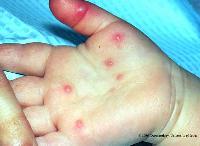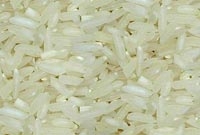Currently, the disease “hand, foot, and mouth” is occurring in several localities. The cause of the disease is enterovirus 71. Below are some basic understandings about the disease “hand, foot, and mouth” and prevention methods.
Basic Understandings of the Disease “Hand, Foot, and Mouth”
 |
| Lesions in hand, foot, and mouth syndrome caused by enterovirus 71 (Photo: vadscorner) |
The hand, foot, and mouth disease caused by enteroviruses is quite prevalent worldwide, particularly in tropical and subtropical countries. The disease has been reported in many countries, with outbreaks recorded in Taiwan and China (1998) and Malaysia (1997). It primarily affects children, with symptoms being more pronounced in boys than in girls.
The disease presents with fever, oral swelling, and a rash with blisters. It usually begins with mild fever, poor appetite, fatigue, and sore throat. 1-2 days later, red spots with blisters appear, which then rupture into sores. These sores typically occur on the tongue, gums, and inside the cheeks. Skin lesions also appear after 1-2 days, presenting as red spots, which may have blisters, are non-itchy, and usually located on the palms and soles. Hand, foot, and mouth disease is entirely different from foot and mouth disease (also known as vesicular stomatitis) in cattle, sheep, and pigs. Although many people confuse the two conditions due to their similar names, they are caused by two completely different types of viruses.
The disease typically has mild clinical symptoms and resolves in 7-10 days. Complications are rare; however, severe cases can present with meningitis symptoms such as fever, headache, neck stiffness, or back pain. Very rarely, complications like encephalitis or acute flaccid paralysis may occur.
This disease is caused by a group of enteroviruses. The most common virus responsible is coxsackievirus A16, although it can also be caused by enterovirus 71 or other enterovirus types. Currently, there are outbreaks in several provinces in our country, confirmed by test results from the Pasteur Institute in Ho Chi Minh City to be due to enterovirus 71.
Hand, foot, and mouth disease is an infectious disease. It spreads from person to person through direct contact with saliva, nasal secretions, throat secretions, or fluid from ruptured blisters, or via the fecal-oral route. The highest transmission risk occurs within the first week after infection; however, the virus can still be shed in feces many weeks later. The virus has been found to persist in water, soil, and vegetables. Infection can also occur through consumption of contaminated food or drinks.
As of now, there is no specific antiviral medication for treatment. Treatment mainly focuses on symptomatic relief to reduce fever and alleviate pain caused by sores, along with managing any complications if they arise.
Prevention Measures
 |
Enterovirus 71 (Photo: yamagiku) |
Currently, there are no specific preventive measures, but the risk of infection can be significantly reduced by implementing the following measures:
1. Personal hygiene, such as frequent handwashing, especially after changing diapers for children.
2. Thoroughly wash tools, utensils, and toys that may be contaminated with virus using soap and water, and then disinfect with 5% chloramine B.
3. Minimize direct contact, such as kissing or sharing utensils with sick children or infected individuals, and apply other measures to reduce transmission via the fecal-oral route, such as consuming well-cooked food and boiled water.
4. Isolating patients or sick children during the initial days of infection can also significantly reduce the risk of transmission.
Remember to wash your hands when:
- Before and after cooking and preparing food.
- Before eating, after using the toilet.
- When hands are dirty.
- Wash hands frequently if there is someone sick in the household.
Proper Handwashing Technique:
- First, wet your hands thoroughly and use liquid soap or bar soap. Place the bar soap on a rack to drain and dry.
- Rub your hands together thoroughly and ensure to wash between your fingers and under your nails.
- Continue to scrub thoroughly for 10-15 seconds. Proper scrubbing with soap will help kill and remove all bacteria adhering to your hands.
- Rinse hands thoroughly and dry with a towel or air dry.
Steps for Cleaning and Disinfecting Surfaces:
- Wear rubber gloves when cleaning up vomit or feces, especially if you have cuts on your hands or if someone in your household is sick.
- First, clean surfaces (tables, chairs, floors) with soap and water or other cleaning agents.
- After cleaning, you can use disinfectants like a 5% chloramine B solution evenly applied to surfaces and left for a few minutes. This process allows pathogens to be in contact with the disinfectant for a longer period.
- Wipe surfaces again with disposable paper towels or cloths. If using cloths, wash them after use.
Keep cleaning and disinfecting supplies out of reach of children.
Always, even when wearing gloves, you should wash your hands after each cleaning and disinfecting session.




















































